Lo spostamento del sito WordPress su un nuovo dominio è un passo importante che necessita di un’attenta pianificazione. Modificare il nome del dominio può influire sulle classifiche SEO, quindi è essenziale gestire il processo con cura.
Abbiamo affrontato con successo il processo di modifica del dominio numerose volte, quindi conosciamo in prima persona le potenziali insidie e sappiamo come evitarle.
Sebbene le fluttuazioni temporanee della SEO siano inevitabili durante una migrazione di dominio, è possibile ridurne l’impatto. Con il giusto approccio, sarete in grado di recuperare rapidamente il vostro traffico di ricerca e le vostre classifiche.
In questa guida vi illustreremo il modo corretto per spostare WordPress su un nuovo dominio senza perdere la SEO.
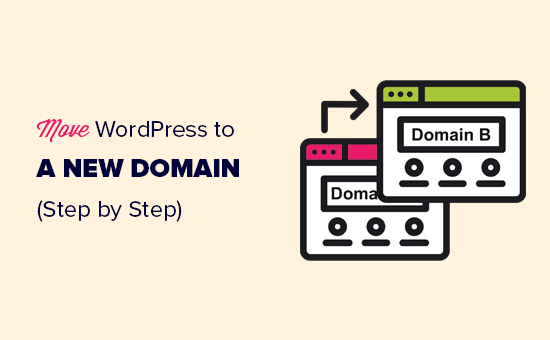
La migrazione del vostro sito WordPress a un nuovo nome di dominio può essere spaventosa, ma non deve esserlo per forza. Siamo qui per accompagnarvi in ogni fase del processo.
Potete fare clic su uno qualsiasi dei link sottostanti per passare a una fase specifica della migrazione del vostro sito WordPress a un nuovo nome di dominio:
- What to Know Before You Change Domains
- Pre-Steps: What You Need to Get Started
- Step 1: Create a Duplicator Package of Your WordPress Site
- Step 2: Create a Database for Your New Domain Name
- Step 3: Unpack WordPress on Your New Domain Name
- Step 4: Set Up Permanent 301 Redirects
- Step 5: Notify Google About Your New Domain
- Notify Your Users About the New Domain Name
- Video Tutorial
Cosa sapere prima di cambiare dominio
Prima di iniziare, ci sono alcune cose da sapere.
Il processo di trasferimento a un nuovo dominio influenzerà temporaneamente il posizionamento sui motori di ricerca, poiché Google e gli altri motori di ricerca dovranno adattarsi alle modifiche.
Ciò influirà temporaneamente anche sul vostro traffico di ricerca. NON SI TRADUCE: si tratta di una situazione normale, che capita a tutti i siti web che passano a un nuovo dominio.
Tuttavia, potete ridurre drasticamente l’impatto SEO seguendo questa guida. Vi mostreremo il modo giusto per spostare il vostro sito WordPress su un nuovo nome di dominio, impostare i reindirizzamenti 301 corretti e informare i motori di ricerca.
Si noti che questa guida non serve a spostare un sito WordPress su un nuovo host. Si tratta solo di cambiare un nome di dominio. Anche se il processo è simile, ci sono alcuni passaggi in più. Questi passaggi extra vi aiuteranno a proteggere le vostre classifiche SEO e il vostro traffico.
Infine, se il vostro vecchio sito è su WordPress.com, dovete seguire le istruzioni della nostra guida su come passare da WordPress.com a WordPress.org.
Passi preliminari: Cosa serve per iniziare
In questa guida si presuppone che il sito web WordPress sia impostato su oldsite.com e che si stia cercando di migrarlo su newsite.com.
Si presume inoltre che abbiate già un account di hosting WordPress e che abbiate familiarità con il pannello di controllo del vostro web hosting.
Dovrete anche sapere come utilizzare un client FTP come FileZilla o come modificare i file utilizzando l’applicazione File Manager disponibile nella dashboard del vostro account di hosting.
Nel caso in cui non abbiate un provider di web hosting o stiate cercando di passare a uno nuovo, vi consigliamo di utilizzare Bluehost (ottimo per i piccoli siti e con un dominio gratuito) e SiteGround o WP Engine (ottimi per i siti più grandi o i negozi online).
Una volta che questi elementi sono a posto, siete pronti per iniziare il processo!
Passo 1: Creare un pacchetto duplicatore del vostro sito WordPress
La prima cosa da fare è creare un backup completo del vostro sito WordPress.
Utilizzerete quindi questo backup per creare un duplicato del vostro sito web, in modo da poter impostare correttamente i reindirizzamenti dal vecchio dominio a quello nuovo.
Sebbene esistano molti plugin per il backup di WordPress, in questo tutorial utilizzeremo Duplicator.
Duplicator è il miglior plugin per il backup e la migrazione di WordPress. Lo abbiamo utilizzato per migrare innumerevoli siti web per le nostre aziende e per i nostri clienti. Abbiamo constatato che funziona in modo affidabile, anche per siti web molto grandi.
Nota: è disponibile anche una versione gratuita di Duplicator, che può essere utilizzata per questa migrazione. Tuttavia, si consiglia di passare a un piano a pagamento per sbloccare altre caratteristiche come i backup automatici nel cloud, il ripristino del sito web in un clic, migrazioni più semplici e altro ancora.
Iniziamo installando e attivando il plugin Duplicator sul vecchio nome di dominio. Per maggiori dettagli, consultate la nostra guida passo-passo su come installare un plugin di WordPress.
Una volta attivato, il plugin aggiungerà una voce di menu Duplicator nell’amministrazione di WordPress. È necessario andare alla pagina Duplicator ” Backups e fare clic sul pulsante ‘Create New’ per creare un nuovo backup o una copia del sito WordPress.
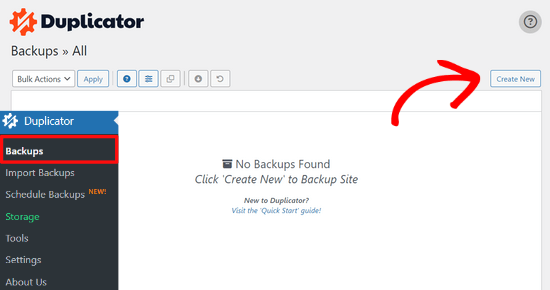
Duplicator inizializzerà ora la procedura guidata posteriore e assegnerà automaticamente un nome a questo pacchetto.
Fare clic sul pulsante “Avanti” per continuare.

Duplicator eseguirà ora alcuni test per verificare se tutto è in ordine. Se il plugin trova un problema, verrà visualizzato un avviso con le istruzioni.
Se tutti gli elementi sono contrassegnati da “Buono”, fare clic sul pulsante “Costruisci”.

Il plugin inizierà a creare un pacchetto Duplicator dei file del sito web. A seconda delle dimensioni del sito, questo processo potrebbe richiedere alcuni minuti.
Una volta terminato, verrà visualizzata l’opzione “Download”. Facendo clic su di essa, si potrà scegliere di scaricare entrambi i file o di scaricare il programma di installazione e l’archivio (zip) separatamente.
Scegliere “Scarica entrambi i file” per scaricarli sul computer.

Il file di archivio è una copia completa dei file di WordPress. Include i temi di WordPress, le impostazioni dei permalink, i plugin, i caricamenti e qualsiasi altro file creato dai plugin di WordPress.
Lo script di installazione è un file PHP che automatizza ed esegue la migrazione di WordPress scompattando il file di archivio.
Fase 2: Creare un database per il nuovo nome di dominio
Prima di spostare il vostro sito WordPress sul nuovo dominio, avrete bisogno di un nuovo database SQL per disimballare WordPress sul nuovo nome di dominio.
Se avete già creato un database, potete saltare questo passaggio.
Per creare un database, è necessario visitare la dashboard del cPanel del proprio account di hosting, scorrere verso il basso fino alla sezione “Database” e quindi fare clic sull’icona“Database MySQL“.
Vi mostreremo come individuarlo su Bluehost, ma le istruzioni di base sono le stesse e dovrebbero valere per tutti i provider di hosting.
Accedere al cruscotto del proprio account Bluehost e fare clic sul pulsante “Impostazioni” sotto il proprio sito web.
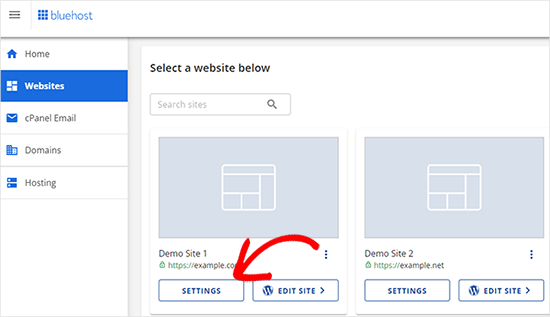
Nelle impostazioni del sito, è necessario passare alla scheda “Avanzate”.
Scorrete un po’ in basso fino alla sezione cPanel e fate clic su “Gestione”.
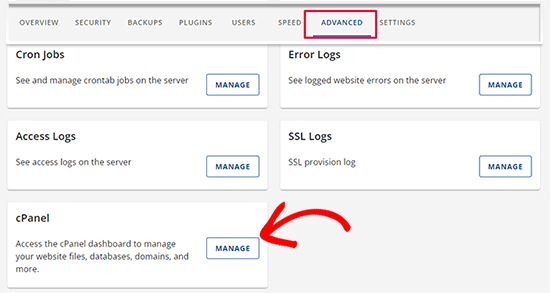
Si aprirà il cruscotto di cPanel.
Scorrete la sezione Database e fate clic sull’opzione “Database MySQL”.
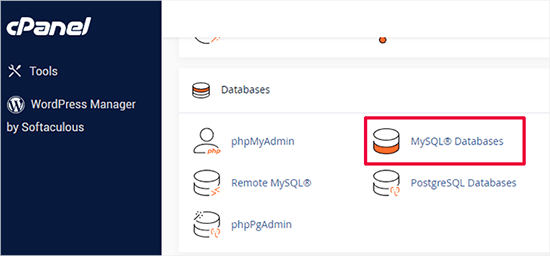
Nota: il pannello di controllo del vostro hosting potrebbe avere un aspetto leggermente diverso da quello delle schermate. Tuttavia, dovreste essere in grado di trovare una sezione Database con un’opzione per creare un nuovo database.
È sufficiente indicare un nome per il database e fare clic sul pulsante “Crea database”.
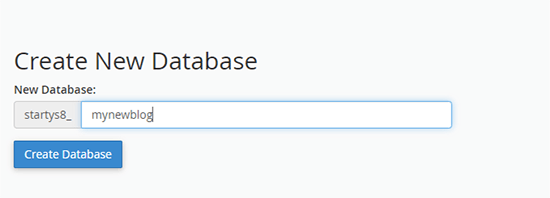
cPanel creerà un nuovo database per voi. Dopodiché, è necessario scorrere verso il basso fino alla sezione Utenti MySQL.
Quindi, fornire un nome utente e una password per il nuovo utente e fare clic sul pulsante “Crea utente”. Assicuratevi di annotare il nome utente e la password in un luogo sicuro.
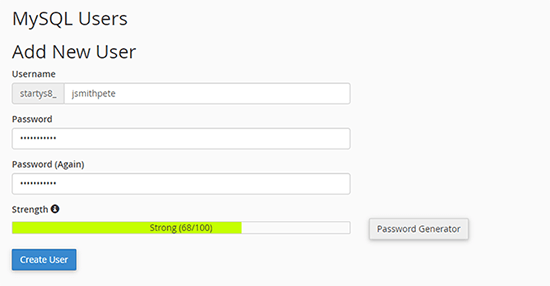
Il nuovo utente appena creato non ha ancora il permesso di lavorare sul database. Modifichiamo la situazione.
Scorrere fino alla sezione “Aggiungi utente al database”. Per prima cosa, selezionare l’utente del database creato dal menu a discesa accanto al campo “Utente”. Quindi selezionare il nuovo database appena creato e fare clic sul pulsante “Aggiungi”.
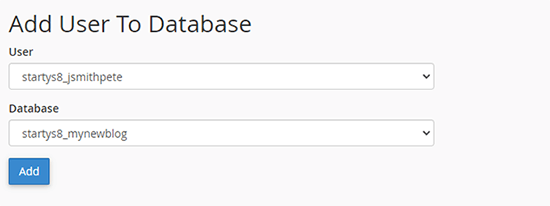
Successivamente, vi verrà chiesto di scegliere i privilegi per l’utente.
Selezionare “Tutti i privilegi” e fare clic sul pulsante “Apporta modifiche” per continuare.
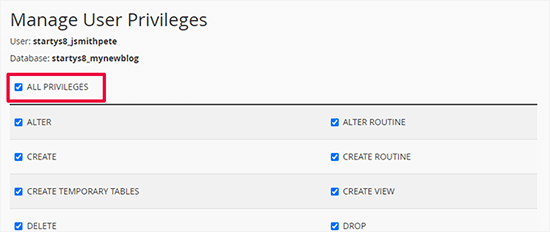
Il database è ora pronto e può essere utilizzato per spostare WordPress sul nuovo nome di dominio.
Assicuratevi di annotare il nome del database, il nome utente e la password. Queste informazioni vi serviranno nella fase successiva.
Fase 3: Disimballare WordPress sul nuovo nome di dominio
Ora è necessario caricare i file di Duplicator scaricati in precedenza sul nuovo nome di dominio.
Il pacchetto Duplicator include anche l’installazione di WordPress. Ciò significa che non è necessario installare WordPress sul nuovo dominio.
Per prima cosa, collegatevi al vostro nome di dominio utilizzando un client FTP. Una volta collegati, assicuratevi che la directory principale del vostro sito web sia completamente vuota.
Dopodiché, è possibile caricare i file dell’archivio e del programma di installazione nella directory principale. Questa è solitamente chiamata public_html.
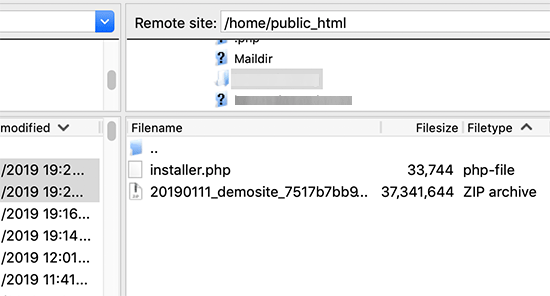
Una volta che entrambi i file hanno terminato il caricamento, siete pronti a scompattare WordPress.
Aprite una nuova scheda del browser e visitate il seguente URL:
http://example.com/installer.php
Non dimenticate di sostituire example.com con il nuovo nome di dominio. In questo modo si avvierà la migrazione guidata di Duplicator.
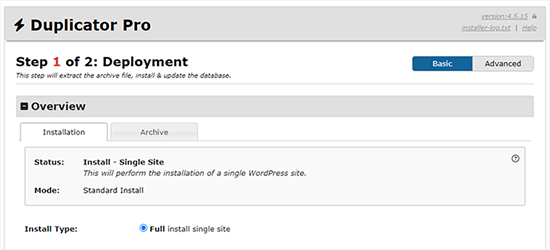
Il programma di installazione cercherà il file di archivio e selezionerà automaticamente le opzioni sullo schermo.
Scorrete un po’ in basso per inserire le informazioni relative al database creato nel passaggio precedente.
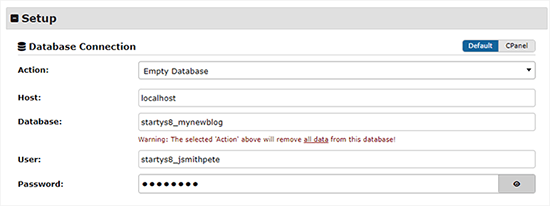
Di seguito, Duplicator mostrerà automaticamente l’URL del vecchio dominio e del nuovo dominio.
Se tutto sembra a posto, fare clic sul pulsante “Convalida” per continuare.
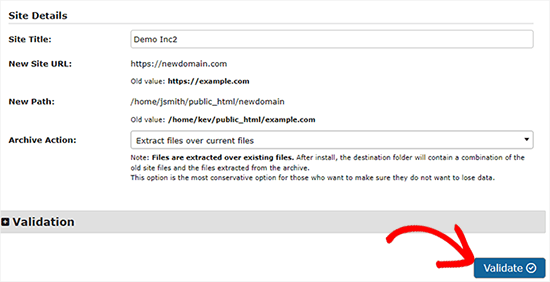
Duplicator tenterà ora di connettersi al database utilizzando le informazioni fornite.
In caso di successo, verrà visualizzato un Passaggio di convalida. In caso contrario, verrà visualizzato un avviso con i dettagli su come risolvere il problema.
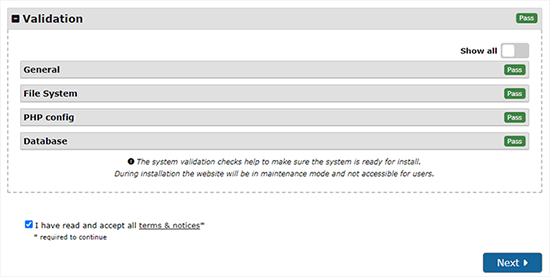
Fare clic sul pulsante “Avanti” per continuare.
Duplicator inizierà a importare il vostro sito web WordPress. Al termine, verrà visualizzato un messaggio di successo con un pulsante di accesso all’amministrazione.
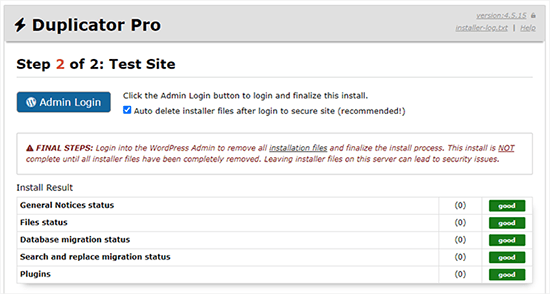
Duplicator aggiornerà automaticamente gli URL al nuovo nome di dominio. Ora è possibile fare clic sul pulsante “Accesso amministratore” per completare le fasi successive.
Passo 4: Impostare reindirizzamenti 301 permanenti
Il passo successivo è quello di indirizzare gli utenti che arrivano sul vecchio nome di dominio verso il nuovo dominio. A tal fine, è necessario impostare i reindirizzamenti 301.
I reindirizzamenti 301 sono molto importanti per la SEO e l’esperienza utente. La loro aggiunta consente di reindirizzare automaticamente gli utenti e i motori di ricerca verso il nuovo nome di dominio.
In altre parole, ogni volta che qualcuno approda a un post o a una pagina del vostro vecchio dominio, verrà automaticamente reindirizzato allo stesso post o alla stessa pagina del vostro nuovo dominio, invece di visualizzare un errore 404.
Per mantenere i reindirizzamenti, è necessario mantenere attiva la vecchia installazione di WordPress, in modo che possa continuare a reindirizzare alla nuova appena creata.
Esistono due modi per impostare i reindirizzamenti. Il primo metodo è semplice e richiede solo pochi clic. Il secondo metodo richiede la modifica manuale dei file.
Metodo 1: Impostare i reindirizzamenti 301 con All in One SEO
Per questo metodo, avrete bisogno di All in One SEO (AIOSEO). È il miglior plugin SEO per WordPress sul mercato e vi permette di ottimizzare facilmente il vostro sito web WordPress per la SEO.
Innanzitutto, è necessario installare e attivare il plugin All in One SEO sul vecchio dominio. Per maggiori dettagli, consultate la nostra guida passo passo su come installare un plugin di WordPress.
Nota: per accedere all’addon per la gestione dei redirect è necessaria almeno la versione Pro del plugin. Potete anche impostare AIOSEO sul vostro nuovo sito WordPress per incrementare ulteriormente il posizionamento sui motori di ricerca e il traffico.
Dopo l’attivazione sul vecchio dominio, è necessario visitare la pagina All in One SEO ” Reindirizzamenti e fare clic sul pulsante “Attiva reindirizzamenti”.
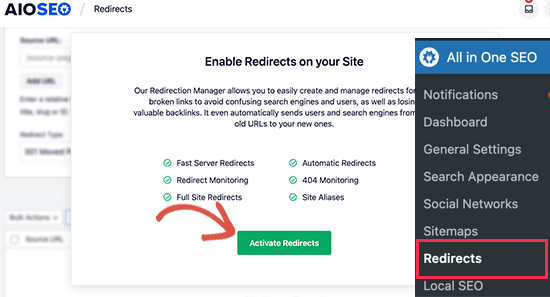
Successivamente, è necessario passare alla scheda “Reindirizzamento completo del sito” e attivare la levetta “Ricolloca sito”.
Dopodiché, è necessario inserire il nuovo nome di dominio accanto all’opzione “Trasferire su dominio”.
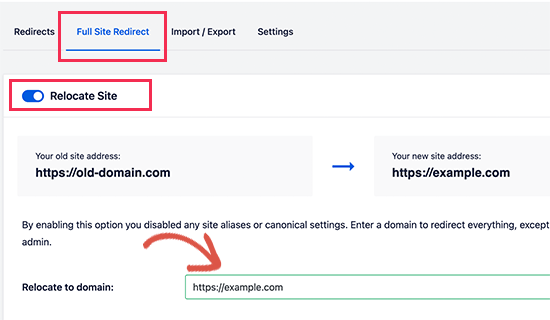
Non dimenticate di fare clic sul pulsante “Salva modifiche” per memorizzare le impostazioni.
Metodo 2: Impostare manualmente i reindirizzamenti al nuovo dominio
Questo metodo richiede la modifica del file .htaccess di WordPress sul vecchio nome di dominio.
Per prima cosa, è necessario collegarsi al vecchio sito tramite FTP e modificare il file .htaccess.
Questo file si trova nella stessa cartella di wp-includes o wp-admin. Aprite il file .htaccess e incollate le seguenti righe di codice all’inizio:
1 2 3 | #Options +FollowSymLinksRewriteEngine onUnchanged: RewriteRule ^(.*)$ http://www.newsite.com/$1 [R=301,L] |
Assicuratevi di sostituire newsite.com con il vostro nuovo dominio nel codice sopra riportato.
Una volta applicate queste modifiche, visitate il vostro vecchio nome di dominio. Dovrebbe reindirizzarvi automaticamente al nuovo dominio.
Se non lo fa, significa che il reindirizzamento non è impostato correttamente e che il vostro server probabilmente non supporta le regole di reindirizzamento. È necessario contattare il team di assistenza della società di web hosting per attivare RewriteEngine.
Passo 5: notificare a Google il nuovo dominio
Ora che avete spostato WordPress su un nuovo nome di dominio e avete impostato i reindirizzamenti, è il momento di notificare a Google il vostro cambio di indirizzo. In questo modo Google troverà rapidamente il dominio del vostro nuovo sito web e inizierà a mostrarlo nei risultati di ricerca.
Innanzitutto, è necessario assicurarsi che il nuovo e il vecchio dominio siano aggiunti a Google Search Console come due proprietà diverse. Per le istruzioni, consultare la fase 1 della nostra guida a Google Search Console.
Successivamente, è necessario selezionare il vecchio nome di dominio come proprietà attiva nella dashboard dell’account di Google Search Console.
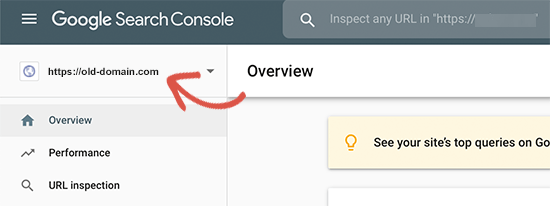
Successivamente, fare clic sul menu Impostazioni dalla colonna di sinistra.
A questo punto è possibile fare clic sullo strumento “Cambiamento di indirizzo”.
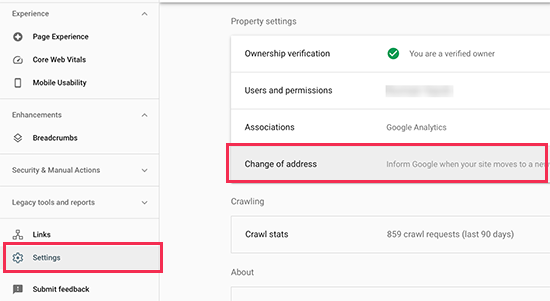
A questo punto, è necessario selezionare il nuovo dominio dalla sezione Aggiorna Google.
Quindi, si deve fare clic sul pulsante “Convalida e aggiorna”.
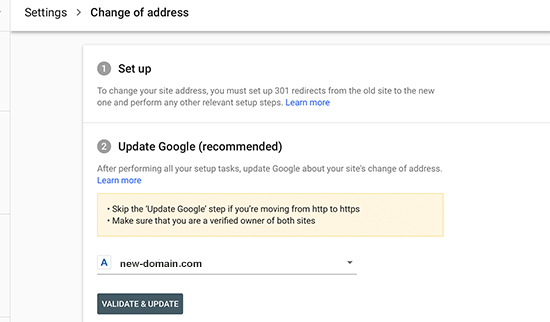
Questo è tutto. Google convaliderà ora che il vecchio dominio sta reindirizzando al nuovo dominio e salverà le modifiche.
Nella schermata successiva, Google Search Console vi mostrerà una procedura guidata passo dopo passo per inviare la richiesta di cambio di indirizzo.
Notificare agli utenti il nuovo nome di dominio
Mentre i reindirizzamenti 301 fanno il loro lavoro, è sempre bene fare un annuncio pubblico della migrazione.
Per farlo, è sufficiente scrivere un post sul nuovo sito e condividerlo sui propri account di social media.
Se avete una newsletter via e-mail o abbonati alle notifiche push, dovreste inviare un annuncio anche a loro.
Questo può essere utile in molti modi.
In primo luogo, è più probabile che i vostri utenti si ricordino del nuovo dominio una volta che lo hanno letto.
In secondo luogo, potete chiedere ai vostri utenti di farvi sapere se notano qualche bug. Da soli non potete testare il vostro sito in ogni tipo di browser o ambiente di sistema, quindi è sempre utile che un paio di occhi nuovi lo guardino.
Video tutorial
Risorse bonus
Gli articoli e le esercitazioni che seguono vi aiuteranno a monitorare e a recuperare le vostre posizioni SEO dopo la migrazione a un nuovo dominio:
- La lista di controllo definitiva per la migrazione SEO di WordPress (per i principianti)
- Come verificare se i post del vostro blog WordPress sono selezionati per le parole chiave giuste
- Come tracciare i visitatori del sito web in WordPress
- Suggerimenti per ottimizzare i post dei blog per la SEO come un professionista (lista di controllo)
Speriamo che questo tutorial vi abbia aiutato a spostare il vostro sito WordPress su un nuovo dominio. Potreste anche consultare la nostra guida su come ottenere un dominio email gratuito o seguire i passaggi della nostra guida completa sulla SEO di WordPress.
Se questo articolo vi è piaciuto, iscrivetevi al nostro canale YouTube per le esercitazioni video su WordPress. Potete trovarci anche su Twitter e Facebook.





Greta Anderson
Wow This worked great! Thanks!
Elliott Bailey
This was exactly what I was after! Thanks ED
Vikram
The installer.PHP Setup is giving 503 Internal Error Or Mis configuration on clicking on next after giving database details in installer.PHP
Jon Wilson
Thanks, it worked perfectly, and my new site is up and running!
The UIs have changed a bit so the screen shots could be updated, but it’s easy enough to figure out. The deleting the database thing is a little scary and confusing. I created a new database and installed it there, which worked well. Otherwise it might have deleted my existing (now old) database and re-written it. I wanted to leave the whole old site intact until the new site was up and then do the 303 redirect. Google’s Search Console UI has also been updated, but that’s easy enough to figure out through a quick google search.
Aditya
It Means That We Should have a New Host For The New SIte to which we are moving ..can we do it with The same hosting on which the old site is
WPBeginner Support
You can change domain names on existing host by simply changing DNS and pointing the new domain to your existing WordPress install. However, you will still need to update URLs in WordPress, setup redirects, and inform search engines about the address change.
Admin
Aditya
My Duplicator Plugin Is Not Generating Installer.php and archive file , It shows some error .
what to do
Aditya
I Am On A Godaddy Economy Linux Hosting With Cpanel
Adick
Thanks for this post, it was very helpful!
Karan Bhagat
Ooops, I am sorry I forgot to ask something in my previous comment, do I need to add newsite.com to my webmaster and analytics separately or will it track the old one ?
Karan Bhagat
Now this is what I call as perfection, did it in less than 15 minutes, no issues, working properly yet and hope no problem arrives even in future as well.
A big thanks to WPBeginner team.
Katie Steckly
so did you have to set up analytics separately? I’m wondering about that as well
Brooke Browne
This is great, thank you! I’m happy to see the plugin you recommend is still alive and kicking, so many years after posting this.
One question I have is if I need to do anything different given my scenario. I have the live old domain, and I have a live dev site that is just simply not indexed. The dev site is the one I want to push to the new domain, so I figured I could skip updating the old domain altogether. It’s fine to just do this process with devwww.olddomain.com > newdomain.com, right?
I’m just the web designer and recently lost my developer, so this is all new to me, and scary. Thanks!
WPBeginner Support
Yes.
Admin
Jasmine
Hi, I want to transfer my blog post from 2 old different niche sites to 1 new authority site. The 2 old niche websites have always been in maintenance mode but register with GWMT.
With that being said, after I transfer my 20+ post total to the new site,
Do I have to still do 301 directs and notify Google of change of address even though it hasn’t been indexed?
Sugianto
Nice post. help me a lot. but now i got new problem after do redirect. i move my old site to new sub-domain name. Now i want to install new fresh wordpress to my old domain name but after instalation when i want to access wp login area, there still login to my new sub-domain site. how to fix that? please help
umukub
If i have oldsite as deindex search engine, then I make redirect to new site. Whats the new site will have impact deindex like old site ?
WPBeginner Support
If your old site was penalized by search engines, and your new site has the same content. Sooner or later your new site will be penalized and deindexed as well.
Admin
Badger
I’ve spent the past year as managing editor of a reasonably popular academic blog. I’m thinking of using duplicator to create a copy of the blog to be stored secretly on a subdomain of my own personal website. That way, I can show prospective employers a record of my editorial work. Do you anticipate this causing any problems for the actual blog as long as I tell search engines not to index the duplicate and don’t set up 301 redirects or notify google?
WPBeginner Support
You can do that but search engines may still crawl your website. To be extra cautious we would recommend you to password protect the entire subdomain with .htaccess. This way search engines will not be able to crawl it and you can send a link along with username and password to anyone.
Admin
Karan Bhagat
Hey,
I have a confusion. Suppose I own a site oldsite and I have migrated it to newsite by redirecting it and the oldsite domain name is about to expire, do I need to renew it every year along with the newsite.com ?
WPBeginner Support
You should keep old domain for at least six months.
Admin
Carmia
Thanks so much for this helpful tutorial! I have successfully moved my site to a new domain with your help.
Prince
Don’t use duplicator it’s not copying fonts. changing with times new roman
Andy
quick question do you know what happens to Facebook likes to individual posts if I change domains and make the 301 redirect for the old one.
Do they carry over as it is a 301 redirect or will the like count drop to zero?
WPBeginner Staff
Please see: How to update URLs when moving your WordPress site
Carol Faughnan
Hi i transferred a subdomain to the main domain and the home page is without the subdomain prefix but the rest of the pages still have the prefix in place. How do I remove it? And do I still need to redirect the URLs in webmaster?
WPBeginner Staff
6-12 months just to be on the safe side.
Mathieu
Thanks. Another question: you say that the search engine rankings will be temporary affected. How great is the loss in organic visits and how long does it last?
Mathieu
Thanks you for such a comprehensive and easy guide. One question: how long do you advise keeping the old domain/site after switching to the new domain?
Tauseef
I have a wordpress.org blog. Now I changed from .com to .org, I was getting anywhere from 4,000 to 400 traffic per day. After the change over I’m lucky to get 160 max and When I went from .com to .org the domain is the exact same one.
why would this be? My domain is still .com, I just changed from wordpress.com to wordpress.org
Alex Sol
Okay, I know this is an old article but I hope I can still get a reply
1. I am thinking of moving blog.old-domain,com to newdomain.com… So is duplicator going to change all links properly? For instance, if the old site had an article: blog.old-domain.com/this-is-article, will it be now created as newdomain.com/this-is-article ?
2. Once I redirect using 301, should I do anything with the content on the old site? Should I leave it or delete it? If I do leave it, I guess I have to keep renewing the old domain as well?
Thanks!
stew7645
Thanks, I found this guide extremely useful and well explained. Managed to move my site from one domain to another in about an hour
WPBeginner Staff
Yes, it is a good idea to submit your sitemap to Bing as well.
Christian Locke
great tutorial, major time saver. I notified Google of the changes through the webmaster tools and it was a breeze. Just want to ask, do you recommend also doing the same thing in Bing webmaster tools? I don’t really put much emphasis on Bing in general but if it would help somehow, I would do it. The process is more complicated and if it can be avoided that’s really what I want to hear but if it’s a good idea, I will take the time to do it. Thanks for offering us this tutorial and taking the time to reply to our questions!
Joe
This article was definitely not written for a beginner. I got stuck around here: “Make sure that the root directory, or the directory where you want to copy your website is completely empty. ” What is the root directory? Then I don’t know what credentials to use to log in anyway.
markyh2904
Sorry I’m late to the party but I’ve only just come across this post when looking how to move one of my WP sites
I have been penalised by G (penguin 3) on one of my music sites as I stupidly bought too many bad link packages from fiverr a few years ago and my domain is just considered spammy now.
Will this work if I want to swap my site content to a new domain BUT not 301 my old site to the new site? And if so,should I de-index my old site immediately after the transfer or before?
Thank you in advance
Hicham Alaoui
Hello,
I displaced my website “http://www.mywebsite.com” to “http://www.mywebsite.com/blog” and after a few months, I displaced posts as before and I deleted all content from /blog.
The problem is that Google still reference the same article as duplicate content, I do the redirection links manually, but there are more than 9000 links deemed not found, I will not finish!
I tried to solve this problem with the tool of Yoast “https://yoast.com/wp-content/permalink-helper.php,” but either it doesn’t work for me, or that I haven’t understand how.
Do you have a solution please?
Thank you.
Tom Durkin
I’ve not thought about looking for a plugin to handle this, will have to take a look!
John R. Meese
Glad to do it!
WPBeginner Staff
If your temporarily URL was public and you didn’t block search engines, then there is a chance that search engines may have crawled the URL. Sometimes a URL may not appear in search index but is still out there and can appear at any time. So you should setup a 301 redirect just to be safe.
On the other hand, if you are pretty sure that it was not crawled or indexed by search engines then you don’t need to set up 301 redirect.
As for step 2. please see our guide on how to use FTP to upload or edit WordPress files.
Chad
If I am just moving from a temporary URL to my permanent URL, should I still do a 301 redirect? Also, if I didnt submit the site to GWT’s yet, I assume I don’t have to change address in GWT’s, just submit to GWT’s after the domain transfer is done, correct? Lastly, in the middle of step 2 above, “Next you need to open your FTP and connect to your new site”….what dose this mean exactly? Open FTP and connect to what? Thanks anyone, pretty newbie here.
WPBeginner Staff
Did you take a look at our free blog setup service.
WPBeginner Staff
Beth, we have a tutorial on how to move a WordPress.com site to Self Hosted WordPress.org
As for your concern about Google Indexing a site that you don’t want to be indexed. You can add a robots.txt file to the root directory of that domain and instruct Google and all other bots not to crawl or index that site.
Beth Terry, CSP
Thank you! You guys are great! I’m a little ahead of the game and did some things out of order. I moved all content to a newly redesigned blog site at a subdomain Then I switched around the theme, etc on the WP.com blog.
I already own the name of my active blog and have been using that for 7 years at the dot com site. So I do have some readers and a ton of content and I have it linked to Twitter and LinkedIn.
I would think that pointing CactusWrangler to my new subdomain blog should bring my indexing and followers with it, but maybe not. All the content and media is on the new site. I did it all with Jetpack plug in… So am I just ready to tell GoDaddy my new DNS information? Unfortunately, Jetpack’s WP support is out till Sept 24!
Yikes ! My goal is to make my website and blog look similar so the linking back and forth is smooth and congruent. Once I get this done, I need to switch the themes on the main website which is an active site since 1998.
I dont’ know how you do this for a living! My eyes are bleary and my brain is mush! ;-D
Beth Terry, CSP
Does this also apply to moving from WP.com to WP.org? I created a subdomain on my website for my blog so I could create a new design. I have had a blog on WP.com and moved the content to the new design. Now I have two identical sites and I need to shut down the .com one before google marks my new one as fake. I’m trying to figure out the next steps. I haven’t technically gone “live” with the subdomain yet, so my URL for the blog still points to the .com site. The comment below about subdomains concerns me. Is there something I need to watch out for?
I know I’m about 3 steps away from solving this, just not sure how to proceed. Thanks for an informative article!!
David
I was dreading moving my wife’s large site to a new URL. Your instructions are the clearest I could find and the process was not so bad after all. Thanks so much. Best of all, it all works. Still have a few page titles, and SEO settings to manually change. Now I don’t have quite the depth of gratitude in the bank with my wife as I had hoped for, but that’s all for the best, I suppose.
Jenny
This was amazing. An absolute lifesaver. Great article!!
Keshav
Hi, I want to move my wordpress blog from blog.yoursite.com to news.yoursite.com Also, I want to change the URL structure from /postname to /post_id/postname
How shall we proceed with this for URL redirection?
Alberto
Hi!
I have a multisite install. I want to move just one website from that installation.
I already have the new website up and running and just need to make the 301 redirects.
The website I’m moving is oldsite.com/the-site and I’m moving it to newsite.com
How can I do this without redirecting all the websites in the multisite installation?
WPBeginner Staff
No, if your users can still access your site and posts at the same URLs as they did before then you need to set up 301 redirection. But if they can’t then this means search engines cant do that either. That way you will be losing a lot of traffic and your search rankings as well.
Susan Finch
Well, since the old domain will simply be a redirect to the new one, this can be problematic since results are all absolute in search engines. Guess I have some 301s to create. Thank you for the quick reply.
Susan Finch
We are simply changing our WP URL – not moving. Are 301 redirects still needed if we follow permalink and notify users steps?
Simon Somlai
The url currently looks like this http://www.oldsite.com/newsite.com how do I change this to a regulat newsite.com?
John Meese
You’ll need to add “http://” before newsite.com for it to work correctly.
Simon Somlai
Alright John! I got it working Thanks for your help man
Thanks for your help man
Vishal Kumar
Simple yet effective… Thanks WPBegginner team.
I have one more query.. It has been 20 days i have moved my site to the new domain successfully by following the above steps. Now given that the old domain is still live and redirects users to new domain, should i consider deleting the old domain data to avoid duplication penalties. Kindly suggest…
Tim Ludy
Great resource thanks! Is there a way to only redirect the blog articles and not the entire site? We’re creating a whole new website for one area of a business so only some of the old websites pages are switching to the new site and the rest are staying on the old site.
Om Livin'
Quick question about Pinterest…would I need to go and change all my pinned links??
Hieu Nguyen
Excellent! Just what I’m searching.
But if I don’t want to move the WP site, is it possible to just change the URL only?
WPBeginner Staff
you can exclude subdomains from your .htaccess file by adding this line just before the RewriteRule line :
RewriteCond %{HTTP_HOST} !^subdomain.example.com$ [NC]
Shah Jahan
Hi, Thanks for the reply, i have added the code,
RewriteCond %{HTTP_HOST} !^subdomain.olddomain.com$ [NC]
RewriteRule ^(.*)$ http://www.newdomain.com/$1 [R=301,L]
now when i try to access subdomain.olddomain.com it redirects to newdomain.com/subdomain.olddomain.com
Shah Jahan Labar
I have some sub domains, when i tries to apply the redirect rule my subdomains also got redirected .
Kasa
What about redirecting subdomain to new different domain?
Is process the same, as you cant change address for subdomain in webasters tools.